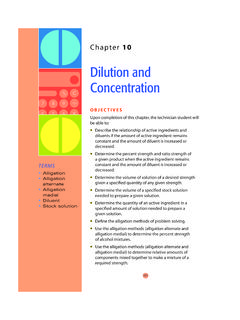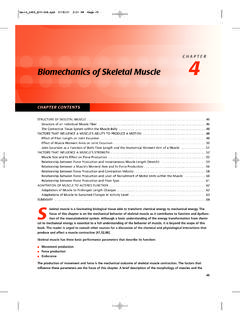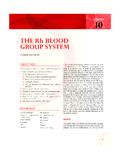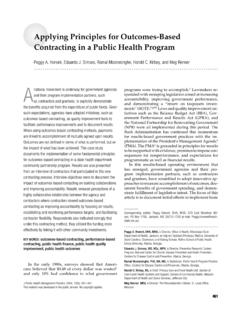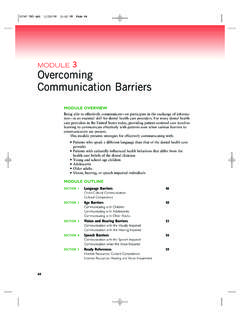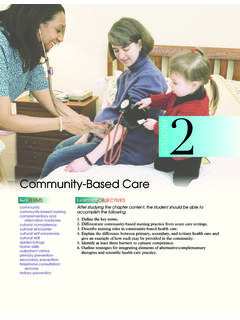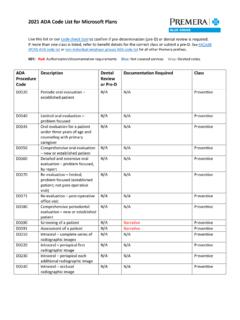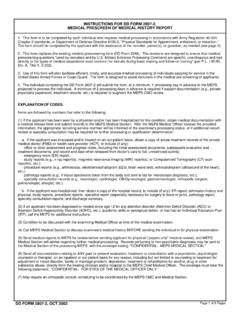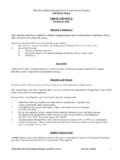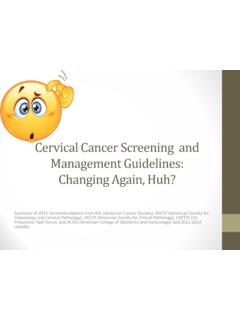Transcription of Chapter 3: Sample - Lippincott Williams & Wilkins
1 09/12/2008 10:37 Page 41 Aptara Inc. Chapter 3. Medical Records: The Basis for All Coding Chapter Outline . Identify administrative and clinical data contained in medical records that are important to the coding Format of Medical Records process. Content of Medical Records . Explain problems associated with coding from Incomplete Medical Records incomplete medical records. Ten Steps for Coding From Medical Records . Identify various medical reports important to the Testing Your Comprehension coding process. Coding Practice I: Chapter Review Exercises . Demonstrate coding from medical reports by using Coding Practice II: Medical Record Case Study the 10-step method.. Demonstrate the use of a Coder/Abstract Summary Chapter Objectives Form and a Physician/Coder Query/Clarification Form.. Identify common formats of the medical record.. Describe the basic steps taken to review a medical record for coding. The coding process begins with a careful and strategic review of the medical record (MR).
2 Whether it describes inpatient or outpatient services, the MR. tells a story of each patient's care and provides the best evidence of what physicians, hospitals, and the health-care team are doing. 41. 09/12/2008 10:37 Page 42 Aptara Inc. 42 PART I: Introduction to ICD-9-CM. This Chapter explains and illustrates the typical structure and main content of a conventional MR, including various medical reports, and its impor- tance to coders. It then presents a traditional step-by-step approach to reviewing and interpreting the MR for accurate coding. This approach serves as the basic framework on which you can build as you become more adept at coding. Medical reports contain consistent content, much of which is dictated by laws and accrediting standards. However, from facility to facility, there is no requirement for reports to be formatted (organized or arranged) in the same manner. Over time, information requirements have been standardized through accrediting agencies such as the Joint Commission, Medicare's Con- ditions of Participation, and state licensure laws.
3 Health-care providers also want to collect and share data to improve their patient services by determin- ing how some institutions can do certain things better than others ( , benchmarking to improve performance). This book uses real-world examples of medical reports, so you will see different formats from various health-care facilities presented in this Chapter 's coding exercises and in those throughout the book. Format of Medical Records The formatting of an MR, whether paper based or electronic, can change from one institution to another, but the contents or data remain consistent. Similar information is usually found, although it can be found in different places within MRs from different institutions. To ensure correct coding, you should be searching for data first. Knowledge of MR formatting, although helpful, is of secondary concern. Different MR formats that you may be exposed to include: . Problem-oriented MR contains four main parts: database, problem list, initial plans, and progress notes.
4 This format allows a physician to focus on the whole patient in the context of addressing all prob- lems. Writing progress notes in the problem-oriented MR is referred to as SOAPing, which follows all problems through a structured approach of Subjective Objective (data), Assessment (of diagnoses), and Plan (for care).. Source-oriented MR forms are organized by departments or units ( , all laboratory, x-ray, nurses' notes, and physician's progress notes are separated), which allows for quick comparison of data over time ( , results of lab work, x-rays, or tests).. Integrated MR integrates various forms and caregiver notes, arranging them in strict chronological order to allow for a quick assessment of the patient at any particular moment in time. Don't worry: you do not have to become an expert at MR formatting to become a good coder. You do need an awareness of the data you are looking for. The arrangement of data within or between pages is not as important as the information itself.
5 Although familiarity with MR formats might help you find data more quickly, by trial and error alone, you will soon find the data and be able to code. You must become familiar with the data contained within MRs to code accurately. 09/12/2008 10:37 Page 43 Aptara Inc. Chapter 3: Medical Records: The Basis for All Coding 43. Content of Medical Records MRs contain administrative and clinical data that assist in the process of cod- ing. Administrative data include routine patient identification such as the patient's name, age, sex, date of birth, address, religious preference, insurance data, and consent for treatment. Clinical data include diagnoses, procedures, and results of tests such as laboratory work, x-ray studies, and operations. Although most registration data (administrative) collected at the time of patient admission contribute to accurate coding, the key information for cod- ing is clinical ( , diagnosis of hepatitis or alcohol abuse and procedures such as cardiac pacemaker insertions or bowel resections).
6 Incomplete Medical Records In the real world, you often must code from incomplete records to process records quickly for reimbursement. Discharge summaries (DS) and other important forms and information are often not yet available at the time of coding. Missing information can result in inaccurate coding that can cause the institution to lose money and create compliance issues ( , fraud and abuse), and the resulting bad data can spill over into inadequate quality-of- care reviews to evaluate patient care concerns. According to the Joint Com- mission, patients' histories and physicals (H&Ps) must be completed within 24 hours, and operative reports must be completed immediately. However, the overall record must be completed within 30 days, and often DS fall within this time period. Coding from incomplete records will not result in 100% cod- ing accuracy. In the face of incomplete records, you may need to query the physician for more information or wait until an important report is available.
7 Just as you need to get a paycheck to pay your bills, a hospital must receive remittance (payments for services) to pay its bills. Under today's prospective payment systems, an MR must be coded before billing and remittance. It is important that health-care professionals remain aware of the effect of incom- plete and untimely physician documentation and its effect on the institution's financial bottom line, performance-improvement activities ( , internal reviews of surgical and mortality cases), and compliance with its governing laws. Because documentation is the basis of all coding, monitoring and actions to improve the timeliness and quality of MR documentation must constantly be stressed to all who are involved in the coding and billing process. Ten Steps for Coding from Medical Records Before beginning the process of coding, make sure sufficient basic materials are in place, including up-to-date ICD-9-CM codebooks, a medical dictionary, and reference books for drugs, human anatomy, and the American Hospital Association's Coding Clinic.
8 Have a scratch pad available to take notes as you go. Make sure you have a quiet place to code and plenty of desk space. Be aware that software products such as encoders are available to help you code and are used by many hospitals. However, before you use software, the basics are best learned starting with the ICD-9-CM codebook. The Office of Inspec- tor General's Model Hospital Compliance Plan also prescribes not to rely 09/12/2008 10:37 Page 44 Aptara Inc. 44 PART I: Introduction to ICD-9-CM. 100% on computerized encoders and indicates that staff must have access to coding Most hospitals use hundreds of different medical report forms. This chap- ter does not illustrate every possible report found within a medical record, but it does introduce those most important for beginning the process of coding. The 10 steps below will give you a framework for coding from MRs. Step 1: Review Face Sheet or Registration Record The Face Sheet or Registration Record (Medical report ) is the front page of the MR.
9 It contains basic patient identification data, insurance information, and sometimes clinical data such as the admitting and final diagnoses. What to look for: . the size of the record and the patient's length of stay, sex, age, and admitting diagnosis all of which will give you insight into the com- plexity of the diagnosis . prospective payment system payers ( , Medicare), which may raise compliance and reimbursement issues Step 2: Review History and Physical, Emergency Department report , and/or Consultant's report The H&P report (see Medical report ) is usually dictated by the attending physician and then transcribed (typed) by medical transcriptionists. The his- tory is an important form that uncovers the chief complaint (CC) of the patient, history of the present illness (HPI), review of systems (ROS), and per- sonal, family, and social history (PFSH). This contains subjective data col- lected from the patient to begin the process of diagnosis by the physician.
10 The physical examination (PE) includes a system-by-system physical examination by the provider to collect objective data on the patient's condition. Review the H&P to determine the chief reason(s) for admission and to begin to get a feel for the possible options for the principal diagnosis ( , the condition, after study, chiefly responsible for occasioning the admission of the patient to the hospital for care ) and secondary diagnoses. Review the history for secondary diagnoses such as comorbidities and other diagnoses affecting patient care that need to be reported per Uniform Hospital Dis- charge Data Set (UHDDS) rules. Review the physical examination for abnor- mal findings. Altogether, the H&P enables the physician to collect both sub- jective and objective data on the patient to establish a provisional diagnosis and begin a plan of care for the patient. Determine the provisional or tentative diagnoses given by the physician and plan for care.
